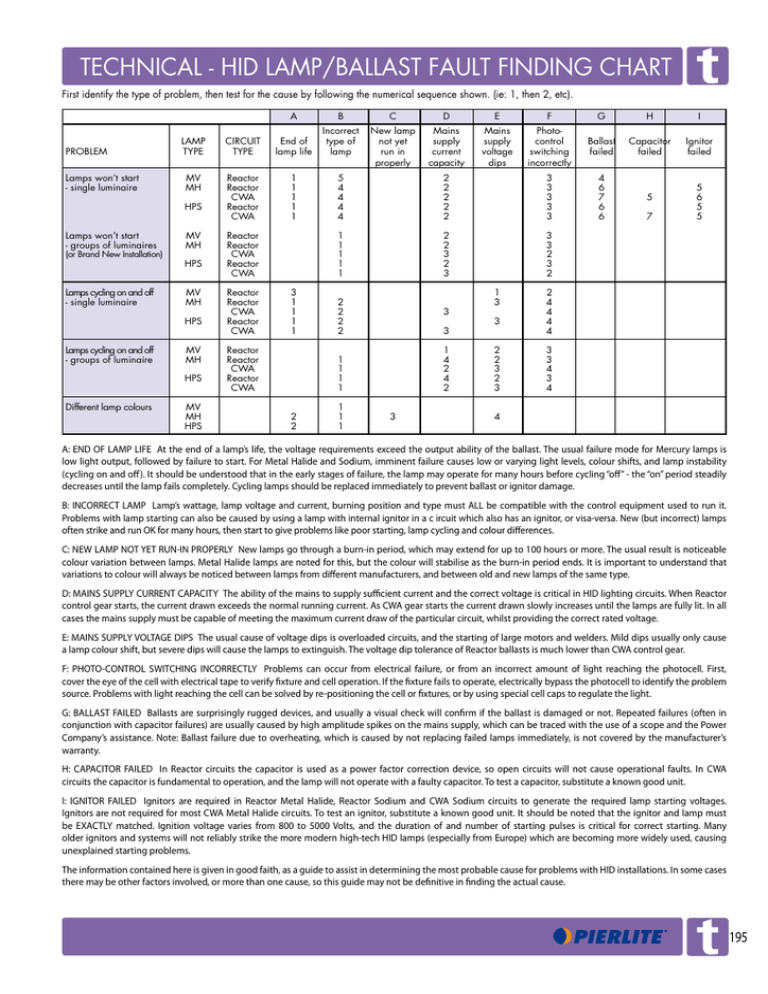technical - hid lamp/ballast fault finding chart
advertisement

TECHNICAL - HID LAMP/BALLAST FAULT FINDING CHART First identify the type of problem, then test for the cause by following the numerical sequence shown. (ie: 1, then 2, etc). A B C Incorrect New lamp LAMP CIRCUIT End of type of not yet PROBLEM TYPE TYPE lamp life lamp run in properly D E F G H I Mains supply current capacity Mains supply voltage dips Photo- control switching incorrectly Ballast failed Capacitor failed Ignitor failed Lamps won’t start MV Reactor 1 5 2 3 4 - single luminaire MH Reactor 1 4 2 3 6 5 CWA 1 4 2 3 7 5 6 HPS Reactor 1 4 2 3 6 5 CWA 1 4 2 3 6 7 5 Lamps won’t start MV Reactor 1 2 3 - groups of luminaires MH Reactor 1 2 3 (or Brand New Installation) CWA 1 3 2 HPS Reactor 1 2 3 CWA 1 3 2 Lamps cycling on and off MV Reactor 3 1 2 - single luminaire MH Reactor 1 2 3 4 CWA 1 2 3 4 HPS Reactor 1 2 3 4 CWA 1 2 3 4 Lamps cycling on and off MV Reactor 1 2 3 - groups of luminaire MH Reactor 1 4 2 3 CWA 1 2 3 4 HPS Reactor 1 4 2 3 CWA 1 2 3 4 Different lamp colours MV 1 MH 2 1 3 4 HPS 2 1 A: END OF LAMP LIFE At the end of a lamp’s life, the voltage requirements exceed the output ability of the ballast. The usual failure mode for Mercury lamps is low light output, followed by failure to start. For Metal Halide and Sodium, imminent failure causes low or varying light levels, colour shifts, and lamp instability (cycling on and off). It should be understood that in the early stages of failure, the lamp may operate for many hours before cycling “off” - the “on” period steadily decreases until the lamp fails completely. Cycling lamps should be replaced immediately to prevent ballast or ignitor damage. B: INCORRECT LAMP Lamp’s wattage, lamp voltage and current, burning position and type must ALL be compatible with the control equipment used to run it. Problems with lamp starting can also be caused by using a lamp with internal ignitor in a c ircuit which also has an ignitor, or visa-versa. New (but incorrect) lamps often strike and run OK for many hours, then start to give problems like poor starting, lamp cycling and colour differences. C: NEW LAMP NOT YET RUN-IN PROPERLY New lamps go through a burn-in period, which may extend for up to 100 hours or more. The usual result is noticeable colour variation between lamps. Metal Halide lamps are noted for this, but the colour will stabilise as the burn-in period ends. It is important to understand that variations to colour will always be noticed between lamps from different manufacturers, and between old and new lamps of the same type. D: MAINS SUPPLY CURRENT CAPACITY The ability of the mains to supply sufficient current and the correct voltage is critical in HID lighting circuits. When Reactor control gear starts, the current drawn exceeds the normal running current. As CWA gear starts the current drawn slowly increases until the lamps are fully lit. In all cases the mains supply must be capable of meeting the maximum current draw of the particular circuit, whilst providing the correct rated voltage. E: MAINS SUPPLY VOLTAGE DIPS The usual cause of voltage dips is overloaded circuits, and the starting of large motors and welders. Mild dips usually only cause a lamp colour shift, but severe dips will cause the lamps to extinguish. The voltage dip tolerance of Reactor ballasts is much lower than CWA control gear. F: PHOTO-CONTROL SWITCHING INCORRECTLY Problems can occur from electrical failure, or from an incorrect amount of light reaching the photocell. First, cover the eye of the cell with electrical tape to verify fixture and cell operation. If the fixture fails to operate, electrically bypass the photocell to identify the problem source. Problems with light reaching the cell can be solved by re-positioning the cell or fixtures, or by using special cell caps to regulate the light. G: BALLAST FAILED Ballasts are surprisingly rugged devices, and usually a visual check will confirm if the ballast is damaged or not. Repeated failures (often in conjunction with capacitor failures) are usually caused by high amplitude spikes on the mains supply, which can be traced with the use of a scope and the Power Company’s assistance. Note: Ballast failure due to overheating, which is caused by not replacing failed lamps immediately, is not covered by the manufacturer’s warranty. H: CAPACITOR FAILED In Reactor circuits the capacitor is used as a power factor correction device, so open circuits will not cause operational faults. In CWA circuits the capacitor is fundamental to operation, and the lamp will not operate with a faulty capacitor. To test a capacitor, substitute a known good unit. I: IGNITOR FAILED Ignitors are required in Reactor Metal Halide, Reactor Sodium and CWA Sodium circuits to generate the required lamp starting voltages. Ignitors are not required for most CWA Metal Halide circuits. To test an ignitor, substitute a known good unit. It should be noted that the ignitor and lamp must be EXACTLY matched. Ignition voltage varies from 800 to 5000 Volts, and the duration of and number of starting pulses is critical for correct starting. Many older ignitors and systems will not reliably strike the more modern high-tech HID lamps (especially from Europe) which are becoming more widely used, causing unexplained starting problems. The information contained here is given in good faith, as a guide to assist in determining the most probable cause for problems with HID installations. In some cases there may be other factors involved, or more than one cause, so this guide may not be definitive in finding the actual cause. 195


